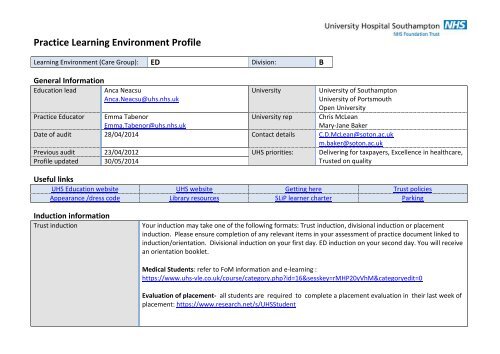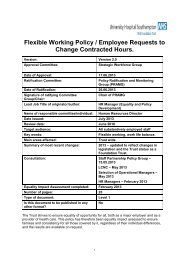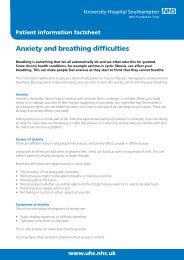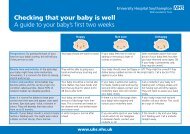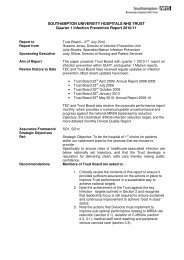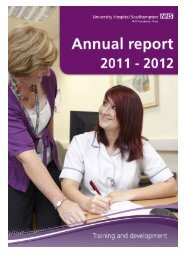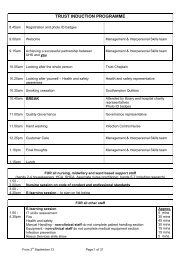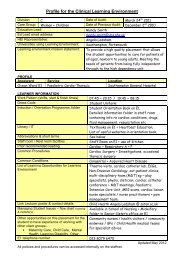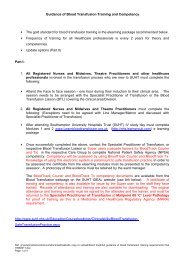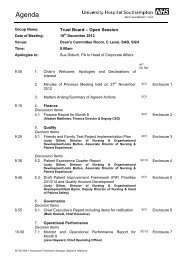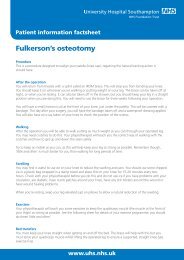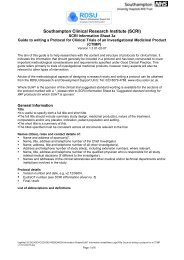Emergency department clinical profile - University Hospital ...
Emergency department clinical profile - University Hospital ...
Emergency department clinical profile - University Hospital ...
- No tags were found...
Create successful ePaper yourself
Turn your PDF publications into a flip-book with our unique Google optimized e-Paper software.
OrientationExpectationsTo report sickness when allocated to ED placement:via switch Tel: 023 8077 7222 Ext 6220, direct dial: 023 8120 6220 and ask for sister in chargeED Secretary is Anita Sanders Ext: 4256Anna Holmes is the ED Student Link• Professional behaviour• Willing to learn• Punctuality• Represent university and UHS• Adherence to appearance policy (above)• Wear ID badge at all times• Expected to do all types of shifts• Ensure contacted <strong>clinical</strong> area for details of assigned mentor prior to placementProfileWard / area Service & client group LocationEDProvide unscheduled and emergency care to the local population;from the very young to the elderly.C level, East Wing, SGHLearner informationWork pattern (shifts, start and finish times) Early 07.30-15.30, Late 12.30-20.30, Middle 10.00-19.00, Twilight 19.00-03.00,IT and resourcesStaff room / rest room facilitiesCommon conditions and assessmentsCommon procedures and expertiseCommon prescribed medicationsAbbreviations and short termsNight 20.00-07.45, Long day 07.30-20.30.Cyber Centre (B Level, near canteen) and via Library (A Level, South Academic Block)There is a coffee room. You will need to provide your own tea, coffee and milk.We treat all conditions from minor injuries/illness to myocardial infarction, major trauma and cardiacarrest.We undertake many procedures which you will have the opportunity to observe. These includesuturing, manipulation of fractures and defibrillation.Wide range of drugs used: Cardiac, Respiratory, Antibiotics, Neuroepileptics, Antidepressants,Anticoagulants, Anti glycaemic, <strong>Emergency</strong> drugs and OD reversal agentsSee separate abbreviations document for Division B on website.
Specific learning opportunities andmultiprofessional working opportunitiesPotential opportunities to meet EUdirectives (Adult nursing only)Recommended reading prior to placement• You will work with your mentor/buddy in all areas of the <strong>department</strong>; minor and majortreatments, paediatrics, Clinical Decision Units and resus.• You will have the opportunity to spend some time with specialist nurses such as the AcuteCoronary Syndrome and Older Persons Nurses.• You may have the opportunity to attend some of our in house training courses such asIntermediate, Paediatric and Trauma Life Support.Vulnerable adult, Mental Health Conditions, Children and Young Adults, Trauma.<strong>Emergency</strong> Nurse Journals – is a specialised publicationOther interesting articles:• Bethel J. ( 2013) Anaphylaxis: diagnosis and treatment , Nursing Standard 27,41,49-56• Bloomfield J., Pegram A. (2012) Improving Nutrition and Hydration in <strong>Hospital</strong>: the nurse’sresponsibility Nursing Standard 25,26 52-56• Busmer L. ( 2013) Diagnosis and Management of postural Tachycardia syndrome , NursingStandard 27,20 35-42.• Hendry C., Farley A., McLafferty E., Johnstone C.(2014) Nervous system, Nursing Standard 28,3245-49• Quinn C ( 2011) What not to eat – the potential dangers of combining certain foods andmedicines, Nursing Standard 25,27 18-19• Gould D ( 2013) health care- Associated Respiratory Tract Infections, Nursing Standard 27,25,50-56• Johnstone C., Hendry C., Farley A., McLafferty E. ( 2014) The Digestive System Part1, NursingStandard 28,24 37-45• Pettie J. , Dow M. (2013) Assessment and management of Paracetamol poisoning in adults,Nursing Standard 27,45,39-47• Sherwen E (2014) Improving end of life care for adults, Nursing Standard 28,32 45-49• Stefanova SD., Cox C., Hill M. (2013) Hypoglycaemia: causes, risk factors and pathophysiology,Nursing Standard 27,42,42-48• Stiles E. ( 2013) Providing Artificial nutrition and hydration in palliative care , Nursing Standard27,20 35-42.• Woodrow P. ( 2013) Intrapleural chest drainage , Nursing Standard 27,40,49-56


